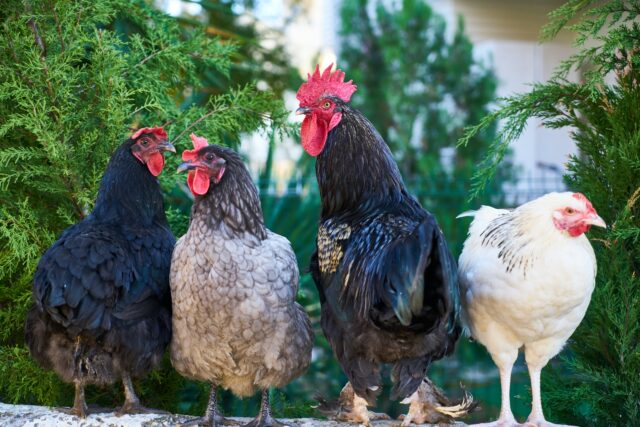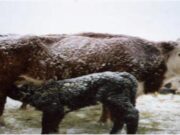
Abstract
Artificial insemination (AI) involves the deposition of semen into the female reproductive tract manually. It starts from the collection of the semen from the male and its evaluation in terms of motility, viability, and concentration followed by its deposition into the female reproductive tract. Artificial insemination (AI) helps to increase poultry production by allowing for the more widespread use of genetically superior cockerels with high productive performance using. Artificial insemination (AI) is a valuable tool for improving the reproductive performance of birds, particularly broiler breeders and turkeys, where fertility is low due to excessive body weight.
In 1899, Ivanov produced fertile chicken eggs using sperm recovered from the ductus deferens after killing a cock. Excellent fertility in poultry can be obtained by artificial insemination compared to natural mating. One male ejaculate can cover up to 20 female birds. Dose of semen is 100–200 million spermatozoa/insemination in 50 microliter volume. Sexual maturity in both male and female bird occurs at 18 weeks of age. The greatest impact of AI has been on genetic improvement and the control of venereal diseases. In order to meet demand, it is now crucial to increase the production of layers due to the sharp rise in chicken meat consumption. Currently, the AI technique is well developed in most poultry species; however, there is a need for a successful development programme of this technique in non-domesticated birds to aid in the creation of viable, self-sustaining populations of critically endangered species.
Advantages of artificial insemination in the poultry
The efficient use of males is one of the advantages of this technology over natural mating. AI is useful for controlling venereal diseases in addition to breeding. Older males with excellent performance can be used for several generations, whereas natural mating limits their useful life. Male birds with injured legs can still be used for artificial insemination. It is possible to eliminate poor fertility caused by preferential mating. Although cross breeding is very successful in natural conditions, there is some colour discrimination because some hens will not mate with a male of a different colour unless they have been reared together. In such cases, AI can aid in successful cross breeding.
Male reproductive system of poultry
Unlike most mammals, the rooster’s testes function at a normal body temperature of around 41°C because the testes are located deep within the body cavity near the kidneys. Similar to the ovary in the hen, their size increases dramatically at around 18 weeks. The daily sperm production rate is approximately 100 million per gram of testicular weight, and it remains fairly constant regardless of mating or collection frequency. Males can produce sperm as early as 12 weeks of age, depending on body size and lighting programme. However, sperm from such roosters is rarely viable, and effective maturity does not occur until the birds are at least 18 weeks old.
Semen collection
In 1937 Burrows and Quinn described a non-invasive method, the abdominal massage method for collection of semen from roosters. The technique involves restraining the male and gently stroking the back of the bird from behind the wings towards the tail with firm rapid strokes. When the male responds with tumescence erection of the phallus, the handler gently squeezes the cloaca, extracting semen through the external papillae of the ductus us deferens (vas deferens) and collecting the semen into a container. Semen is collected 4–6 times in a week. A thrice weekly frequency (alternating days) maintained the optimum output of spermatozoa, resulting in good fertility in chickens, whereas two collections per week were shown to yield better results in pekin breeder ducks.
Evaluation of semen quality
In poultry, the quality of semen is the prominent determinant of fertility and hatchability of eggs. Semen should be routinely examined for volume, color, concentration, motility, viability, and morphology of spermatozoa.
1.Semen color
In general, the colour of the sperm indicates the density of the ejaculate. Domestic fowl sperm ranges from a dense opaque suspension to a watery fluid secreted by various reproductive glands. A good-quality semen sample is thick and pearly white in colour, and any other colour indicates contamination; for example, yellow and green-colored semen indicates faecal or urine contamination.
2.Ejaculate volume
The cockerel ejaculates between 0.1 and 1.5 ml, with 0.6 ml being the average ejaculate volume recorded. The average volume ejaculated with the abdominal massage technique is 0.25ml. It is critical to understand that the total number of sperm collected per ejaculation is determined by semen volume and sperm concentration (volume multiplied by concentration). This could help determine the number of insemination doses that can be prepared.
3.Semen pH
The pH of the sperm varies slightly between breeds and bird species. The optimum pH range for sperm is between 7.0 and 7.4.
4.Sperm motility
Sperm motility is an indicator of live sperm and of the quality of the semen sample. Evaluation of sperm motility is conducted with fresh and diluted semen and generally analyzed under the light microscope (100× magnification). Sperm motility is a primary determinant of fertility in domestic fowls.
5.Sperm concentration
Semen collected from domestic cockerel contains an average sperm concentration of 5000 ×106 sperm/ml.
6.Sperm viability
The percentage of dead and abnormal spermatozoa in a sample should be less than 10%. The viability of sperm is determined using an eosin-nigrosin stain followed by microscopic examination.
7.Sperm morphology
Sperm cell has a head, a midsection, and a tail. The head contains the nucleus, which contains the genetic material that is the sire’s genetic contribution to the offspring. The nucleus is protected by the post-nuclear cap, which covers the posterior part of the nucleus, and the acrosome, which covers the anterior part of the nucleus.
Semen diluent and preservation of poultry semen
Semen can be diluted to cover approx 5-20 hens. Most diluents include sodium glutamate, glucose, fructose, and specialized buffers to keep the ph around 7.0 and the osmolarity around 400 milliosmole. Glutamate is especially important if the semen will be stored for more than 4-6 hours. Semen should be stored at low temperatures ranging from 4-10°C for long periods of time. In terms of fertility, poultry sperm responds very poorly to cryopreservation. There are various types of semen diluters that are commercially available. The semen may be diluted with a solution known as modified ringer’s solution.
Artificial insemination of hens
In poultry, there are two methods of semen deposition. These are the intra peritoneal insemination and vaginal insemination methods. The most reliable and successful method of inseminating poultry is to deposit the sperm directly in the mid-vaginal area. The female bird is restrained first, and then pressure is applied to the left side of the abdomen around the vent. The cloaca everts and the oviduct protrudes, allowing a syringe or plastic straw to be inserted 1 inch (2.5 cm) into the oviduct and the appropriate amount of semen to be delivered. As the inseminator expels the semen, pressure around the vent is released, assisting the hen in retaining spermatozoa in the vagina or oviduct. Khelo24Bet is an online sports betting and casino platform that offers a wide range of games and sporting events for users. https://drivify.in/ provides access to a variety of gambling games, including live casinos, slots, and other popular entertainment options.
Timing and frequency of artificial insemination
The presence of hard-shelled eggs in the uterus of hens is uncommon in the evening. As a result, inseminations performed in the afternoon or evening are more fertile than those performed in the morning. Inseminations should be performed on two consecutive days during the first week, and then once a week thereafter as long as fertile eggs are required. Eggs are fertile after the second day of insemination and can remain fertile for two weeks or more, according to observations. If another male is to be used on the same hen in a breeding programme, it is recommended that a three-week period elapse before the second male is used.
More study is needed to determine the effects of disease, age, diet, photoperiod, and other managemental parameters on reproductive performance in domesticated birds.
Also, read | 𝗕𝗥𝗘𝗘𝗗𝗘𝗥 𝗠𝗔𝗡𝗔𝗚𝗘𝗠𝗘𝗡𝗧: 𝗜𝗠𝗣𝗢𝗥𝗧𝗔𝗡𝗖𝗘 𝗢𝗙 𝗨𝗡𝗜𝗙𝗢𝗥𝗠𝗜𝗧𝗬 𝗔𝗡𝗗 𝗚𝗥𝗔𝗗𝗜𝗡𝗚
Authors:
Sujata Jinagal1, Anil Kumar2, Krishan Yadav3*
*1M.V.Sc. Scholar, Department of Veterinary Gynaecology and Obstetrics, Lala Lajpat Rai University of Veterinary and Animal Sciences, Hisar, 125004.
*2M.V.Sc. Scholar, Department of Veterinary Surgery and Radiology, Lala Lajpat Rai University of Veterinary and Animal Sciences, Hisar, 125004.
*3M.V.Sc. Scholar, Department of Veterinary Gynaecology and Obstetrics, Post Graduate Institute of Veterinary Education and Research (PGIVER), Rajasthan University of Veterinary and Animal Science (RAJUVAS), Bikaner, Rajasthan, 302031
Corresponding author: krishyadav9600@gmail.com





























